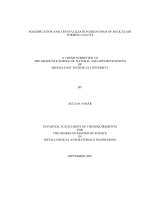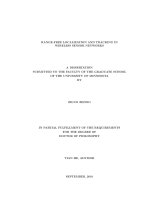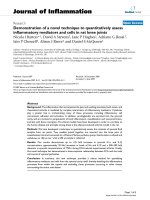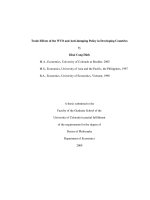A thesis submitted to the department of Accounting and Finance, Kwame Nkrumah University of Science and Technology, in partial fulfillment of the requirement for the award of
Bạn đang xem bản rút gọn của tài liệu. Xem và tải ngay bản đầy đủ của tài liệu tại đây (608.88 KB, 62 trang )
EFFECT OF BANK INNOVATIONS ON FINANCIAL PERFORMANCE OF
UNIVERSAL BANKS IN GHANA
By
William Yeboah Sampong (BBA)
A thesis submitted to the department of Accounting and Finance,
Kwame Nkrumah University of Science and Technology,
in partial fulfillment of the requirement for the award of
MASTER OF BUSINESS ADMINISTRATION IN
FINANCE
August, 2015
DECLARATION
I hereby declare that this submission is my own work towards the MBA and that, to the best
of my knowledge, it contains no material previously published by another person nor material
which has been accepted for the award of any other degree of the University, except where
due acknowledgement has been made in the text.
William Yeboah Sampong
……………………
Signature
………………..
Date
Certified by:
Dr. Kwame Mireku
…………………….
Signature
………………..
Date
Certified By:
Dr. K. O. Appiah
……………………
Signature
ii
……………….
Date
ACKNOWLEDGEMENT
My sincere gratitude and appreciation goes to my research assistants, especially Rita Kyiraa
and all the bank officials whose help contributed to the success of this study.
I am also very grateful to all lecturers of KSB especially DR. Kwame Mireku for his
guidance and supervision of this theses.
I very much appreciate the effort of my wife, (Mrs. Evelyn Sampong), my children (Kendra
Sampong and Jeffery Sampong Senibour) and my mother, Mrs. Beatrice Sampong, whose
players and support keeps spurring me on to this height.
Finally, I thank the almighty God for giving me the strength, knowledge, wisdom and
understanding to go through this course successfully.
iii
DEDICATION
To the Almighty God be the glory for making my dreams come into reality.
iv
ABSTRACT
The Ghanaian Banking industry is witnessing a revolution as a result of technological
innovations that have become a common feature of banking in the contemporary business
environment. The arrival of the Internet and the proliferation of mobile telecommunication
companies in Ghana present both an opportunity and a challenge to banks in Ghana. The test
for the banking sector has been how to profitably formulate a new service delivery means in
such a way that its clients will enthusiastically learn to use and trust. The purpose of this
work is to identify the effect of bank innovations on the financial performance of universal
banks in terms of their income or revenue generation, liquidity, efficiency, profitability and
the general patronage of banking services in Ghana. This work is a survey of bank executives
from fifteen (15) universal banks in Accra and Kumasi. Questionnaires were administered to
find out the opinions of bank executives on the effect of bank innovations on financial
performance. It was discovered that most of the innovations have positive effect on the
income generating potentials of the banks, they also improves efficiency, liquidity and
profitability of the banks. This study also found out that E-zwich as an innovation in the
financial sector has no direct effect on financial performance of the universal banks in Ghana.
It is recommended that corporate banks must make it a policy to establish an efficient and
effective marketing department to oversee the publicity of all bank innovative products. The
Government through Bank of Ghana must continue to invest in researching into innovations
in the financial sector, and the universal banks whose operations are affected by any national
innovative products or platforms such as E-zwich should be consulted and their concerns
factored in the product before implementation.
v
TABLE OF CONTETS
DECLARATION......................................................................................................................ii
ACKNOWLEDGEMENT ......................................................................................................iii
DEDICATION......................................................................................................................... iv
ABSTRACT .............................................................................................................................. v
LIST OF TABLES .................................................................................................................. ix
CHAPTER ONE ...................................................................................................................... 1
INTRODUCTION.................................................................................................................... 1
1.0 Background of the Study ................................................................................................. 1
1.1 Statement of the Problem ................................................................................................. 4
1.2 Objective of the Study ..................................................................................................... 5
1.3 Research Questions .......................................................................................................... 6
1.4 Significance of the Study ................................................................................................. 6
1.5 Scope and Limitations of the Study ................................................................................. 7
1.6 Organization of the Study ................................................................................................ 7
CHAPTER TWO ..................................................................................................................... 8
LITERATURE REVIEW ....................................................................................................... 8
2.0 Introduction ...................................................................................................................... 8
2.1 Definition of Key Terms .................................................................................................. 8
2.1.1 Financial Performance .............................................................................................. 8
2.1.2 Return on Asset ......................................................................................................... 8
2.1.3 Universal Bank.......................................................................................................... 9
2.1.4 Innovation ................................................................................................................. 9
2.1.5 Return on Equity ....................................................................................................... 9
2.2 Bank Innovation ............................................................................................................... 9
2.3 Financial Performance of Universal Banks ................................................................... 12
2.4 Bank Innovations and Customer Deposits ..................................................................... 13
2.5 Types of Bank Innovation Products ............................................................................... 14
2.5.1 Internet Banking...................................................................................................... 14
2.5.2 E-ZWICH ................................................................................................................ 15
2.5.3 Telephone Banking ................................................................................................. 15
2.5.4 Automatic Teller Machine (ATM).......................................................................... 16
2.5.5 Mobile Banking ...................................................................................................... 17
vi
2.5.6 Branch Networking ................................................................................................. 17
2.5.7 Electronic Fund Transfer At Point Of Sale (EFTPOS) ........................................... 18
2.5.8 Cash Smart Cards .................................................................................................... 18
2.5.9 The Electronic Funds Transfer System (EFTS) ...................................................... 19
2.6 Critique of Existing Literature ....................................................................................... 20
CHAPTER TREE .................................................................................................................. 21
RESEARCH METHODOLOGY ......................................................................................... 21
3.0 Introduction .................................................................................................................... 21
3.1 Research Design............................................................................................................. 21
3.2 Population of the Study.................................................................................................. 22
3.3 Sample Size and Sampling Technique ........................................................................... 22
3.4 Data Collection .............................................................................................................. 24
3.5 Data Analysis ................................................................................................................. 24
3.6 Reliability and Validity of Data ..................................................................................... 24
3.7 Ethical Issues ................................................................................................................. 25
CHAPTER FOUR .................................................................................................................. 26
DATA PRESENTATION AND ANALYSIS ....................................................................... 26
4.0 Introduction .................................................................................................................... 26
4.1 Demographic Characteristics of Participants ................................................................. 26
4.1.1 Sex of Respondent .................................................................................................. 26
4.1.2 Age of Participants .................................................................................................. 27
4.1.3 Departmental Distribution of Respondents ............................................................. 28
4.1.4 Banking Sector Experience of Respondents ........................................................... 28
4.2 Data Analysis of Bank Innovations ............................................................................... 29
4.2.1 Effect of Bank Innovations on Total Revenue ........................................................ 29
4.2.1.1 Automated Teller Machines (ATMs)............................................................... 29
4.2.1.2 E-ZWICH Payment Systems and Bank Revenue ............................................ 30
4.2.1.3 Mobile/Internet Banking and Bank Revenue ................................................... 31
4.2.2 Influence of Bank Innovations on Return on Assets .............................................. 32
4.2.2.1 Automated Teller Machines (ATMs)............................................................... 32
4.2.2.2 E-ZWICH Payment Systems ........................................................................... 33
4.2.2.3 Mobile/Internet Banking .................................................................................. 34
4.2.3 Consequence of Bank Innovations on Bank Profitability ....................................... 35
4.2.3.1 Automated Teller Machines (ATMs)............................................................... 35
vii
4.2.3.2 E-ZWICH Payment Systems ........................................................................... 36
4.2.3.3 Mobile/Internet Banking .................................................................................. 37
4.2.4 Impact of Bank Innovations on Patronage of Banking Services ............................ 38
4.2.4.1 Automated Teller Machines (ATMs)............................................................... 38
4.2.4.2 E-ZWICH Payment Systems ........................................................................... 39
4.2.4.3 Mobile/Internet Banking .................................................................................. 40
CHAPTER FIVE ................................................................................................................... 42
SUMMARY OF FINDINGS, CONCLUSION AND RECOMMENDATIONS .............. 42
5.0 Introduction .................................................................................................................... 42
5.2 Summary of Findings ..................................................................................................... 42
5.3 Conclusion ..................................................................................................................... 44
5.4 Recommendations .......................................................................................................... 45
5.5 Areas for Further Studies ............................................................................................... 45
REFENCES ............................................................................................................................ 46
APPENDICES ........................................................................................................................ 48
Appendix A Letter of Introduction ...................................................................................... 48
Appendix B Questionnaire ................................................................................................... 49
viii
LIST OF TABLES
Table 3.1 Distribution of Population and Sample Size ............................................................ 23
Table 4.1.1 Sex of participants ................................................................................................ 26
Table 4.1.2 Ages of Respondents ............................................................................................ 27
Table 4.1.3 Department of Respondents .................................................................................. 28
Table 4.1.4 Experience of Participants .................................................................................... 28
Table 4.2.1 Automated Teller Machines (ATMs) and Bank Revenue .................................... 30
Table 4.2.2.2 E-Zwich Payment Systems ................................................................................ 31
Table 4.2.1.3 Mobile/Internet Banking .................................................................................... 32
Table 4.2.2.1Automated Teller Machines (ATMs) ................................................................. 33
Table 4.2.2.2 E-Zwich Payment systems ................................................................................. 34
Table 4.2.2.3 Mobile/Internet Banking .................................................................................... 35
Table 4.2.3.1 Automated Teller Machines (ATMs) ................................................................ 36
Table 4.2.3.2 E-Zwich Payment systems ................................................................................. 37
Table 4.2.3.3 Mobile/Internet Banking .................................................................................... 38
Table 4.2.4.1 Automated Teller Machines (ATMs) ................................................................ 39
Table 4.2.4.2 E-Zwich Payment systems ................................................................................. 40
Table 4.2.4.3 Mobile/Internet Banking .................................................................................... 41
ix
CHAPTER ONE
INTRODUCTION
1.0 BACKGROUND OF THE STUDY
This study is to show how financial innovative products affect the financial performance of
the Ghanaian Banking Sector. Rose (1999) defines banks as any financial institutions which
offer a broad range of financial services, including the provision of credit, deposits and
payment systems and employ an extensive variety of financial intermediation functions in
any business economy. According to Lerner and Tufano (2011), „financial innovation is
defined as the „act of creating and then popularizing new financial assets or products, as well
as new financial technologies, organizations and markets‟. In recent past, it was possible for
banks to satisfy their customers and to meet their own performance targets without the need
to develop any new products to enhance service delivery due to the fact that account holders
and banks were few, with the low volume of transactions, and luck of competition in the
banking industry. According to the 2014, Ghana Banking survey by PricewaterhouseCoopers
„Ghana has 27 universal banks, 137 rural and community banks, 58 non-bank financial
organizations including, leasing firms, mortgage providers, finance houses, and saving and
loan institutions‟. These do not include the hundreds of „Susu‟ collectors, who serve as
informal, small-scale depository financial organizations for market sellers, artisans and
commercial transport operators. Of the twenty-seven (27) universal banks, 10 are owned by
Ghanaians while the remaining is backed by international owners.
Bank innovations involve the development of new products/services or production process
that lead to efficient and effective operations. Nofie (2011), described innovations in the
banking industry as the entrance of new or improved products or a processes which reduces
the operational cost of rendering existing banking services. According Agboola (2003), the
1
adoption of Information and Communication Technology in financial institutions have
improved customer services, facilitated the accuracy of account, provided for home and
office banking services, ensured convenient business hours, timely and fair attention, and
improved service delivery.
The liberalization of banking industry by the bank of Ghana, and the resultant rise in
competition among the banking and non-banking financial institutions in the Ghanaian
financial market has brought to the fore the need for the creation of innovative financial
assets or products that would maintain current customers and attract new ones. The Banking
Act, 2004, has reinforced the threat of new entrants of competitors into the financial market,
and the continuous education has created public awareness of banking services which have
resulted in a rise in customer quest for quality and improvement in products and introduction
of new ones. The banking sector in the country comprises mainly universal banks, savings
and loans organizations and also special rural and community banks.
The traditional commercial banking is declining in terms of competition and this may
threaten the financial stability of the banks. This will result in increasing bank failures
through the exposure to higher risk by the banks, which either makes more risky advances to
clients or by involving in 'nontraditional' banking activities that guarantee better returns but
with additional risk. The conventional manual system of banking, for instance, put a lot of
stress and strain on bank staff that has to attend to many more customers and handle more
paper work. To reduce the Increasing cost of manual processing of customers‟ data, Banks
are thus compelled to introduce measures that will increase their profitability, capitalization,
deposit and fund mobilization as well as reduce their operational costs, to serve the customers
who complained of time wasted in queuing for banking services compelling most of them to
keep their savings at home and thereby adversely affecting deposit mobilization.
2
In furtherance of the objective to compete, universal banks in the Country decided to
restructure their system of operations by embarking on Bank Innovation or other Direct
Customer banking Sales services, which offer consumers and businesses the opportunity to
undertake a lot of banking functions at home instead of been physically present in the
banking hall. The customer is able to do home banking through the internet and telephones
that provide him/her with a lot of convenient banking services. The customers are able to
transfer funds from one account to another, make loan applications, request for cheque books,
monitor the loan payments, pay bills, check accounts balances, buy and sell financial assets,
and perform other services. Through innovation home banking has become easier and very
convenient to users. Home banking gives the user the following advantages; privacy, speed,
accuracy and the ability to do business in all the 24 hours in a day. The banks also levy
moderate commission for the use of home banking innovation. One banking function that is
not currently available to home bankers is the ability to receive cash; therefore, the users must
still attend to the bank teller or automatic teller machine (ATM)
The internet bank operates solely through the Internet, which is a global network of computer
networks with no "brick and mortar" building or the branch offices. Internet banking has the
following advantages; firstly, it eliminates many of the expenses of the conventional banks,
secondary, the banks can hypothetically pay depositors a higher rate of interest on deposits as
compared with the conventional commercial bank‟s rate. Thirdly, financial institution that
uses the internet banking for service delivery removes or minimizes the need to build more
branches to serve clients efficiently. Fourthly, Internet banking has the prospect of convenient
banking to the customer who is able to manage personal accounts and to perform other
services such, as paying bills on-line, applying for auto loans and also the ability to offer the
customer a 24-hour telephone response to the customers who can discuss his/her needs with
bank service representatives.
3
This help to reduce long queues, long waiting hours and inaccessibility to banking services
outside banking hours and weekends. When there were only three commercial banks, for
example in Ghana, there was limited or no competition at all, but with the emergence of new
banks and government deregulation of Interest rates. Competition has become very keen. The
universal banks, therefore, developed different innovative products in order to stay in
business. The networking system is a typical example of this. In recent times, also banks
have developed new methods of advancing loans to their customers especially salaried
workers. This is done by entering into agreement with established organizations to facilitate
the grant of loans to their staff. This has proved very helpful to workers, and relieved
employers of the burden of having to look for funds to grant loans to their workers.
1.1 STATEMENT OF THE PROBLEM
The traditional commercial banking is declining in terms of competition and this may
threaten the financial stability of the banks. Therefore, banks in Ghana must have business
strategy that include the development, implementation and evaluation of the effect of
innovative products, aimed at maintaining existing customers and attracting new ones, such
innovations must also improve efficiency and profitability of the banks. Banks in Ghana have
been generally slow in adopting new and modern innovative ways of improving service
delivery to their customers, and three reasons may be attributable to their lackadaisical
attitude toward the development of new financial innovations. Firstly, the payback period for
the initial capital outlay may be longer and unacceptable to management and shareholders,
secondly, these innovations may not have a positive correlation with financial performance in
terms of efficiency and profitability and thirdly, the innovations may, nevertheless have their
peculiar problems like computer and internet frauds, frequent breakdowns of the system and
lack of personnel with requisite skill and commitment, which the banks needed in order to
satisfy their customers, stay in business and effectively compete. However, some universal
4
banks in Ghana are developing innovative products in place of their old modus operandi of
manual ways of doing business. Modern technologically advanced methods liken E-zwich,
Internet Banking, and Telephone Banking, which are all envisaged to reduce operational
costs, and to attract more retail depositors to the banks. According to Frimpong (2010),
„innovations provide an impetus for banks to improve their market performance by
recovering from palpable inefficiencies prevalent in the banking industry, as is the case in
Ghana and other emerging countries‟. But what still remains uncertain to bank executives is
whether bank innovations assist to attain the expected financial performances of the banks
and the customer welfare‟.
Even though bank innovations have attracted considerable
interest to researchers, the effect of these innovations on bank performance in Ghana has not
been extensively researched into, therefore, the need to conduct this study. The results of this
study will determine whether bank innovations have resulted in improving efficiency and
profit levels of universal banking institutions in Ghana.
1.2 OBJECTIVE OF THE STUDY
The general objective of this work is to identify the effect of bank innovations on the
financial performance of the Ghanaian universal banks. The study also pursued other specific
objectives in evaluating the impact of bank innovation on financial market as follows:
1. To examine the effect of innovations on the revenue or income of universal banks in
Ghana.
2. To examine the effect of these innovations on liquidity and efficiency of banks in
Ghana.
3. To examine the effect or the consequences of bank innovations on the levels of profits
of the universal banking institutions in Ghana.
4. To find out the effect of bank innovations on patronage of banking services.
5
1.3 RESEARCH QUESTIONS
With regard to the research objectives the following sampled questions adapted from
previous studies by Ngumi (2013) were posed to management, heads of departments and staff
of selected commercial banks in Ghana:
1. Whether Automatic Teller Machines (ATMs) have had an encouraging impact of
improving bank earnings in terms of commissions?
2. Whether ATMs control the reduction of costs, and thereby resulting in improved
return on assets for the bank?
3. Whether Income from E-Zwich has high mark-up which leads to more profits for the
banks?
4. Whether Mobile/Internet Banking achieves less costs of operation resulting in greater
amounts of profits over their useful life to the firm?
5. Whether Mobile/Internet Banking facilitates or enhances the accessibility to funds by
customers for ease of withdrawal?
6. Whether Mobile Banking is attracting more retail depositors for the bank?
1.4 SIGNIFICANCE OF THE STUDY
The study is significant in terms of its contribution towards understanding the important role
of bank innovations in the Ghanaian banking industry and the whole economy of Ghana. This
would enable shareholders or investors and management to be able to deal with and justify
the resources spent on bank innovations. It would also bring to the fore the impact of these
innovative products on the banks, and how it will help improve service delivery to their
customers and to improve profitability and efficiency. „Innovations in electronic banking (ebanking) in Ghana have helped to improve not only efficiency but also financial
intermediation‟ (Acquah, 2006).
6
The benefits of bank innovation would not be left out on policy makers as it would be useful
to Bank of Ghana who has the desire to grow the financial services in Ghana and to reduce
the level of cash transactions in the country. The findings and recommendation of this study
would bring to light the areas of support that government of Ghana should pay attention to
towards bank innovations, and to formulate fiscal and monitory policies that aid the universal
banks.
The research work will become a secondary source of information for any one who wants to
undertake a further research work in this area. The suggested recommendations will also
help the public and banking officials in their work.
1.5 SCOPE AND LIMITATIONS OF THE STUDY
The study was restricted to fifteen (15) universal banks out of the twenty seven (27) banks in
Ghana. The research was also restricted to only banks in Accra and Kumasi. There are many
bank innovations but the study concentrated on E-zwich, Automatic Teller Machines and
Mobile/internet Banking. Banking confidentiality is cardinal principle under banking law and
therefore, strategic level staffs of the banks were reluctant of answering questions.
1.6 ORGANIZATION OF THE STUDY
The organization of the study will be as follows: Chapter one will deal with or talk about the
background of the study, statement of the problem, significance of the study, research
question, scope and limitations of the study and finally the organization of the study. Chapter
two is also another which will take into account the literature review on the topic the
researcher is writing on. Chapter three of the study will cover the research methodology.
Chapter four of the study will deal with analysis and presentation of data collected Chapter
five which will be the last chapter will take into account summary of findings, conclusions
and recommendations based on a researcher‟s topic.
7
CHAPTER TWO
LITERATURE REVIEW
2.0 INTRODUCTION
This chapter undertakes an academic appraisal of diverse literatures pertaining to bank
innovation. The study focuses on the following important areas of the phenomenon under
review; bank innovations and their effect on bank performance.
2.1 DEFINITION OF KEY TERMS
2.1.1 FINANCIAL PERFORMANCE
Financial performance can be defined as the measurement of how well an organization has
put to good uses, its resources or assets to conduct business and generate revenue and thereby
making profit which is the ultimate goal of every business organization, for its stakeholders.
Financial performance could also be described as the measurement of an organization‟s total
financial wellbeing over a specific period of time, usually one year. The same bank could
have it performance compared over a number of years; there could also be comparison of
performances between firms across the banking industry.
2.1.2 RETURN ON ASSET
The return on asset is a ratio which measures how efficient and effective a firm is using its
resources. It shows the ability of the management of a bank to generate additional income
from the investment in innovations. This ratio is indicative of the profitability of a bank and
the higher this ratio, the more efficient management is using resources at their disposal. It
also measures the relationship in terms of ratio between profit before interest and taxes and
the total assets of a bank.
8
2.1.3 UNIVERSAL BANK
According to Rose (1999), a bank is a financial institution that undertakes a broad variety of
financial services; especially the provision of credit, savings and payment services and
undertakes a broad variety of financial activities in any business economy. This definition, by
far goes beyond the meaning of commercial banking which is restricted to the provision of
services such as accepting of deposits, giving loans, operating checking accounts, electronic
funds transfer, and foreign exchange transactions and are mainly in the area of commerce.
Universal banks are not restricted in their scope of operations. They deal in commerce,
merchandising, agriculture, investment in socio-economic development and the provision of
services to the peripheral markets like unbanked or under-banked in an economy.
2.1.4 INNOVATION
Innovation is the development of new approaches or techniques for delivering existing
product, or on the other hand, the creation of new product or requirement. According to
Lerner & Tufano (2011), two categories of innovation exist, which are product and process
innovations. The former are exemplified by new derivative contracts, new corporate
securities or new forms of pooled investment products, while the latter are typified by new
means of distributing securities, processing transactions or pricing transactions.
2.1.5 RETURN ON EQUITY
Return on equity is a ratio that measures the periodical relationship between the profit
available to shareholders and their total equity of the firm. It shows how profitable the
shareholder‟s investments have been over a period, usually one year.
2.2 BANK INNOVATION
The importance of innovation in the Ghanaian Banking Industry abounds in several banking
literature, few of which are indicated as follows:
9
According to Ghana Banking Survey (2008), carried out by PricewaterhouseCoopers,
„valuable returns, convenience banking, Presence everywhere banking, Satisfying banking
hall experience, Good customer service, and a Convincing image of a strong bank would be
among key factors consumers would consider in deciding where to deposit their funds‟.
PricewaterhouseCoopers (2014) survey confirmed that „bankers (executives) consider that
technological factors will have the greatest influence on the future business of banking, and
that key drivers for informing decisions about the industry‟s uptake and deployment of
technology for the increasing wealth, demand for convenience, cost-efficiency, and increased
banking penetration‟. According to Al-Hawari and Ward (2011), „the banking industry in
mature markets has witnessed a wholesale and ongoing shift in confidence, and never before
has loyalty management and personal customer attention been such an issue for the sector‟.
As rivalry within the banking sector intensified convenience and improved returns on deposit
funds continued to be the trademark of bank‟s marketing strategies for extensive growth over
the recent past years, many more banks commenced identified variations of the same range of
products-spots of virtual banking or innovation (e.g. e-banking and m-banking products).
Zero balance accounts, quick cash, easy cash, school transactions solutions, juvenile saving
accounts, card-based solutions.
Mobile/Internet banking has many advantages to the customer and the bank or financial
institution. It increases ease of banking, grants more access to savings and significantly
reduces time for banking. From the perspective of the bank, Mobile/internet banking reduces
operational costs of the bank considerably as compared with the cost of operating additional
branches to expand operations. Internet banking has all the impact on productivity of ATMs,
except it lacks the function of cash dispensing by the ATMs as an innovation that provides
retail banking services even after banking hours (24 hours a day). It accrues continual
productivity for the bank.
10
The selection of particular banking products to be used by a bank is strategic in achieving a
good reputation or image for the bank both in the short and long run. Apart from the high
reputation and prestige, they also help in improving the banks chances of increasing its
deposit mobilization. Even if the bank‟s sole purpose is to maximize share holders‟
investments, the concern for bank reputation may also be important. Investors‟ belief about
the bank‟s ability of offering good and unique services may affect the price at which the bank
can raise capital, employ people and sell its products.
According to Rose (1999), the combination of both the Automated and human tellers imply
more productivity for the bank during banking hours. Also as it saves customer‟s time in
service delivery as an alternative to queuing in banking halls, customer can invest such time
saved into other productive activities. ATMs are a cost efficient way of yielding higher
productivity as they achieve higher productivity per period of time than human tellers (an
average of about 6400 transactions per month for ATM compared to 4300 for human tellers,
(Rose 1999)
The automation of the Ghanaian domestic payments system is will help the banks reduce the
processing cost associated with the use of cheques to make payments whilst keeping control
over payments in the hands of the their managements. This for both banks and customers,
will save time, costs, offer control of cash, improve relations with vendors and simplify
reconciliation. The adverse effect of this product is the cost of set up and maintenance.
The cheque clearing process is very labour intensive and requires that paper cheque be moved
from point to point. Movement of physical cheques is by a bearer to speeding up the
collecting process. Through technology some banks are speeding up these processes by
transmitting the Magnetic Ink Character Recognition (MICR) data electronically to the
11
paying bank followed by the physical Cheque. Cheque processing is another area in banking
that technology is influencing significantly.
Technological innovations initiated by financial institutions have resulted in a significant
increase in public savings in terms of time and money. Innovation significantly supplemented
the central banks‟ effort in mopping up excess liquidity and controlling monetary growth,
thereby reducing inflation. It also enables banks to adapt to new situations to increase the
scale and range of their operation and to cater for both domestic and international needs as
well as helping banks in networking their operations.
2.3 FINANCIAL PERFORMANCE OF UNIVERSAL BANKS
Creativity and innovations are crucial for the survival of every business been it private or
public sector. According to Damanpour et al., (2009), „innovation affects a firm‟s
performance positively‟. According to Frimpong (2010), „innovations provide an impetus for
banks to improve their market performance by recovering from palpable inefficiencies
prevalent in the banking industry, as is the case in Ghana and other emerging countries‟.
Profitability and efficiency are the major motives for banks to assume risks for expansion in
its operations. Some of the measures that are used in evaluating a bank‟s profitability and
efficiency are Return on Asset, Return on Equity, Net Profit Margin. Bank innovations have
the potentials to increase the volume of retail transactions through increase usage of
electronic transfers and payment systems which encourage the banking business. According
to Mawutor (2014), „the introduction of E-banking has indeed had a positive effect on the
profitability of Agricultural Development Bank (ADB) since it was introduced‟.
Table 2.2.2.1 shown below is a secondary data from a survey work done by
PricewaterhouseCoopers on the „opportunities and challenges that technology-driven factors
will most likely bring to the future business of banking in Ghana‟. The table shows the
12
responses on how bank managers anticipate how technological factors may affect the future
of the Ghanaian banking business. According to the survey bank executives confirmed that,
these technologies or competitive drivers will have a significant increase in balance
sheet/cost/revenue of the banking sector over the next 5 years. From the table, revenue
especially non-interest income streams, to be generated outweighed the cost of implementing
bank innovations.
PricewaterhouseCoopers 2014
2.4 BANK INNOVATIONS AND CUSTOMER DEPOSITS
According to Domeher et al., (2014), „the ease with which customers can use the innovation,
the compatibility of the innovation with customers‟ needs, the perceived usefulness thereof,
the amount of information provided on the innovation and the level of customers‟ education
all have a significant positive impact on the adoption of e-banking innovations in the
Ghanaian banking industry‟. The inauguration of national electronic payment system or
13
platform popularly called E-zwich, by the Bank of Ghana, has the objective of extending the
coverage of financial services and transactions to a large segment of the population, who
stand to benefit because the system is safe, secure and very efficient to users. The e-zwich
which is a biometrics smart card works both on-line and off-line and is meant to ensure
cashless transaction and rope in the large untapped informal sector. It would promote access
to deposited funds and ease the transfer of funds from one account to another, and also
eliminate the burdensome and insecure physical cash transactions. Some of the challenges
faced by bank innovation is the difficulty of changing the Ghanaians‟ perceptions about
technology and their wait-to-see attitude. Therefore, all users including the small micro
business enterprises as well as the larger populace must be motivated to take advantage of the
platform and be linked up to the larger financial system.
2.5 TYPES OF BANK INNOVATION PRODUCTS
2.5.1 INTERNET BANKING
Internet banking involves the conduct of conventional banking activities on the Internet, that
is, the global network of computer which does not depend on any "brick and mortar" office
building; it offers financial services that are accessed through the Internet‟s World Wide Web
(W.W.W.). By reducing the overhead expenses of traditional banks, Internet banks in theory
can offer clients better interest rates on deposits than that of traditional banking average rate.
Banks often rely on the Internet to convey information about financial products to the general
public, replace business conducted at the branch offices, which do away with the need to put
up new branches, and to serve clients more efficiently. Internet banking sites present the
prospect of more suitable means to manage customer finances, and such activities as paying
bills on-line, searching for mortgage or auto loans, applying for credit cards, and finding the
nearest ATM or branch office. Several Internet banks also offer 24-hour telephone support,
so clients can discuss their needs with bank service representatives directly. Internet Banking
14
has the disadvantage of exposure to internet fraud, frequent network breakdown and virus
infection.
2.5.2 E-ZWICH
The national switch, otherwise known as E-zwich, which is a banking arrangement that make
available a common electronic platform linking the payment systems of all license banks and
non-bank financial organizations in Ghana, is a project undertaken by the Bank of Ghana, in
association with other banks to bring the payment systems in Ghana to the best global
standards. The Ghana interbank payment and settlement systems (GIPS) Limited, is the
company responsible for managing the national electronic banking switch. customers of ezwich can load money onto a „smartcards‟, which function in a like manner of bank debit or
credit cards, except that they require biometric (fingerprint) identification instead of pin
numbers and the cards can work in e-zwich Point of Sale (POS) machines that are „off-line‟,
or do not require an active connection to the bank.
The benefits of the e-zwich card includes: improved revenue from a rising smartcard
customer base; reduced cash holdings, bank charges, communications costs, reconciliation
problems and reduction of risks linked with fraud; Additionally, the ability of the system to
reach the unbanked easily would bring more people outside the banking system into the
financial system and increase deposits mobilized by bank to enable them to create more
credit; The users will also profit from a more comfortable, less risky and easier means of
spending and receiving money through the use of the smart card.
2.5.3 TELEPHONE BANKING
Telephone banking is a bank innovation that enables the clients of a bank to undertake
banking activities through the telephone. It can be considered as a form of remote or virtual
banking, which is basically the performance of bank financial activities through
15
telecommunication devices whereby bank clients can undertake retail banking business by
calling on the telephone or mobile communication unit which is connected to a system of the
bank by Automated Voice Response (ABR) technology, Balachandher et al, (2001).
For the assurance of the system‟s security, the client must be first authenticated via a numeric
or verbal password or by means of security questions being asked by a live representative at a
centre or branch. With a clear exception of cash dispensing in the form of deposits and
withdrawals, it offers almost all the functions of account balance information, standing
orders, ordering of cheque books and change of address. In addition to the self-service
activities listed earlier, telephone banking operatives are usually trained to do what was
conventionally obtainable exclusively at the branches.
According to Leow (1999),
„Telephone banking, has numerous benefits for both customer and banks. It increases
convenience expand access and significant time saving. On the other hand, from the banks
perspective, the costs are substantially lower than those of branch based services‟. Telephone
banking has nearly all the effects on performance of ATMs, apart from the ability to produce
or dispense cash to the user. As delivery medium that offer retail banking activities to
customers even after banking hours (24hours a day), it provides persistent efficiency for the
bank. It makes banking at the client‟ convenience possible both in their homes and offices,
the customer can perform banking without visiting the ATMs or the branch office of the
bank. These results in saving time spent on banking, it also provides convenience, efficient
and higher productivity for both the bank and customers.
2.5.4 AUTOMATIC TELLER MACHINE (ATM)
ATMs are the most commonly used bank innovation in recent times. Almost all the universal
banks in Ghana have this facility available for their customers. On most contemporary ATM,
the clients is identified after inserting a plastic ATM card with a magnetic stripe or a plastic
16









